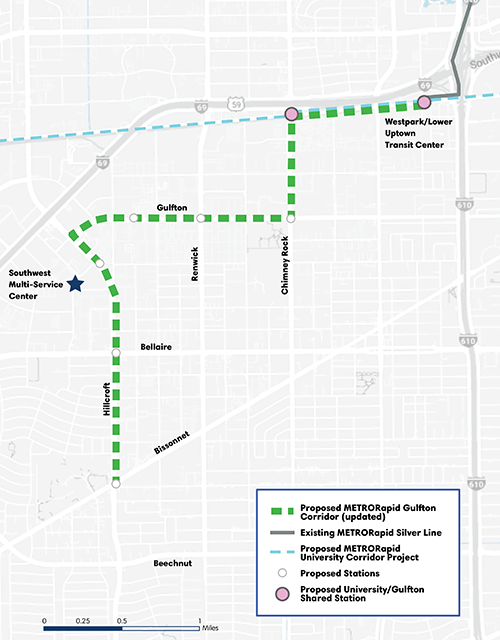Long-sought improvements to transit service in Gulfton – arguably among the Houston region’s most transit-starved areas – have an official line on the map, though rapid service remains years away.
Metropolitan Transit Authority officials on Thursday approved the preferred route for a planned bus rapid transit extension into Gulfton. The line would run from the Westpark/Lower Uptown Transit Center along Westpark near Loop 610, heading west on Westpark before turning south at Chimney Rock. Dedicated lanes for the buses would then run from Chimney Rock to Gulfton to Hillcroft, where the line would end at Bissonnet.
Service would not start until 2027, under preliminary plans submitted to the Federal Transit Administration. Extending the Silver Line into Gulfton is estimated to cost $220 million, based on the plans Metro submitted to federal officials seeking grant funding for the project.
Regardless of how much local and federal money pays for the project, officials and Gulfton residents said the line is an investment in a place that’s often been passed over.
“This is something that is, unfortunately, long overdue,” said State Rep. Gene Wu, the Houston Democrat who represents Gulfton in Austin.
The line, Wu said, “is going to change lives,” noting the importance of connecting workers and students to schools and jobs.
Adequate transit is especially needed in Gulfton, proponents of the line said, because of the high use of buses to get around the region. According to the Kinder Institute for Urban Research, 12 percent of the Gulfton area does not have access to a car or truck, compared to 2 percent of nearby Bellaire.
Despite huge demand, bus routes now serving the area can be cumbersome even workers headed to the Uptown area, less than two miles away, but across Interstate 69.
“They have to take three buses to get to their jobs,” resident Noelia Fadic told Metro’s board. “It is not a direct route and it takes them a long time.”
See here for some background. This should make a big difference for a dense and transit-dependent part of town. The connection to the forthcoming Universities BRT line means a rapid transit connection to the entire Metro light rail/BRT system, as you can see from the MetroRapid map. You might need to make a second transfer, but it’s still going to be faster and more convenient than the existing service.
If the complaint about Metro and public transit in general for Houston is that you can’t really get anywhere, look at that map again, and remember that it doesn’t include the local bus service, which also includes some high-frequency lines. There’s a lot more coverage than you think, and while it will take longer than driving, you don’t have to worry about (or pay for, which is an expensive proposition in some parts of town) parking. You can take your bike with you, or hop onto a BCycle bike at some locations. You want to drive less, you have a lot more options than you might think, that’s all I’m saying. In a few years, you’ll have a lot more.

